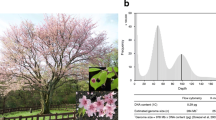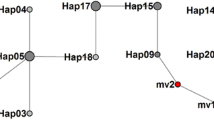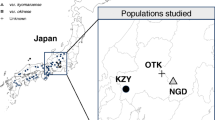Abstract
Prunus yedoensis Matsumura is one of the popular ornamental flowering cherry trees native to northeastern Asia, and its wild populations have only been found on Jeju Island, Korea. Previous studies suggested that wild P. yedoensis (P. yedoensis var. nudiflora) is a hybrid species; however, there is no solid evidence on its exact parental origin and genomic organization. In this study, we developed a total of 38 nuclear gene-based DNA markers that can be universally amplifiable in the Prunus species using 586 Prunus Conserved Orthologous Gene Set (Prunus COS). Using the Prunus COS markers, we investigated the genetic structure of wild P. yedoensis populations and evaluated the putative parental species of wild P. yedoensis. Population structure and phylogenetic analysis of 73 wild P. yedoensis accessions and 54 accessions of other Prunus species revealed that the wild P. yedoensis on Jeju Island is a natural homoploid hybrid. Sequence-level comparison of Prunus COS markers between species suggested that wild P. yedoensis might originate from a cross between maternal P. pendula f. ascendens and paternal P. jamasakura. Moreover, approximately 81% of the wild P. yedoensis accessions examined were likely F1 hybrids, whereas the remaining 19% were backcross hybrids resulting from additional asymmetric introgression of parental genotypes. These findings suggest that complex hybridization of the Prunus species on Jeju Island can produce a range of variable hybrid offspring. Overall, this study makes a significant contribution to address issues of the origin, nomenclature, and genetic relationship of ornamental P. yedoensis.






Similar content being viewed by others
References
Altschul S, Madden T, Schaffer A, Zhang J, Zhang Z, Miller W, Lipman D (1997) Gapped BLAST and PSI-BLAST: a new generation of protein database search programs. Nucleic Acids Res 25:3389–3402
Arnold M (1997) Natural hybridization and evolution, Oxford series in ecology and evolution. Oxford University Press, Oxford
Bushakra JM, Sargent DJ, Cabrera A, Crowhurst R, Girona EL, Velasco R, Symonds VV, Knaap E, Troggio M, Gardiner SE, Chagné D (2011) Rosaceae conserved orthologous set (RosCOS) markers as a tool to assess genome synteny between Malus and Fragaria. Tree Genet Genomes 8:643–658
Cabrera A, Kozik A, Howad W, Arus P, Iezzoni AF, van der Knaap E (2009) Development and bin mapping of a Rosaceae Conserved Ortholog Set (COS) of markers. BMC Genom 10:562
Chapman MA, Chang J, Weisman D, Kesseli RV, Burke JM (2007) Universal markers for comparative mapping and phylogenetic analysis in the Asteraceae (Compositae). Theor Appl Genet 115:747–755
Cho M, Kim C, Kim S, Kim T, Heo K, Jun J, Kim S (2014) Molecular and morphological data reveal hybrid origin of wild Prunus yedoensis (Rosaceae) from Jeju Island, Korea: implications for the origin of the flowering cherry. Am J Bot 101:1976–1986
Earl D, vonHoldt B (2012) STRUCTURE HARVESTER: a website and program for visualizing STRUCTURE output and implementing the Evanno method. Conserv Genet Resour 4:359–361
Genovart M (2009) Natural hybridization and conservation. Biodivers Conserv 18:1435–1439
Harn C, Kim Y, Yang S, Chung H (1977) Studies on the origin of Prunus yedoensis Matsumura. I. A comparative electrophoretic study on wild P. subhirtella in Mt. Hanla, cultivated P. yedoensis and P. donarium. Kor J Bot 20:1–5
Jeong Y-M, Chung W-H, Chung H, Kim N, Park B-S, Lim K-B, Yu H-J, Mun J-H (2014) Comparative analysis of the radish genome based on a conserved ortholog set (COS) of Brassica. Theor Appl Genet 127:1975–1989
Jung Y-H, Oh M-Y (2005) Phylogenetic relationships of Prunus (Rosaceae) in Korea and Japan inferred from chloroplast DNA sequences. Kor J Genet 27:279–288
Jung Y, Ko M, Oh Y, Kim G, Chung Y, Kim M, Oh M (1997) Phylogenetic relationship among selected taxa of Prunus in Mt. Halla and cultivated Prunus yedoensis by the RAPD analysis. Korean J Plant Taxon 27:415–428
Jung Y, Ko M, Oh Y, Han S, Kim M, Koh S, Oh M (1998) Genetic relationship of Prunus yedoensis, native and cultivated, based on internal transcribed spacer sequences of ribosomal DNA. Korean J Genet 20:109–116
Kalendar R, Lee D, Schulman A (2014) FastPCR software for PCR, in silico PCR, and oligonucleotide assembly and analysis. Methods Mol Biol 1116:271–302
Knight R (1969) Abstract bibliography of fruit breeding and genetics to 1965; Prunus. Commonwealth Agricultural Bureaux, Farnham Royal
Koehne VE (1912) 95 Prunus yedoensis var. nudiflora, nov. var. Von E. Koehne. Repert Specierum Nov Regni Veg 10:507
Krutovsky KV, Troggio M, Brown GR, Jermstad KD, Neale DB (2004) Comparative mapping in the Pinaceae. Genetics 168:447–461
Kumar S, Stecher G, Tamura K (2016) MEGA7: molecular evolutionary genetics analysis version 7.0 for bigger datasets. Mol Biol Evol 33:1870–1874
Langmead B, Salzberg S (2012) Fast gapped-read alignment with Bowtie 2. Nat Methods 9:357–359
Larkin M, Blackshields G, Brown N, Chenna R, McGettigan P, McWilliam H, Valentin F, Wallace I, Wilm A, Lopez R, Thompson J, Gibson T, Higgins D (2007) Clustal W and Clustal X version 2.0. Bioinformatics 23:2947–2948
Liewlaksaneeyanawin C, Zhuang J, Tang M, Farzaneh N, Lueng G, Cullis C, Findlay S, Ritland CE, Bohlmann J, Ritland K (2008) Identification of COS markers in the Pinaceae. Tree Genet Genomes 5:247–255
Matsumoto D, Tao R (2016) Distinct self-recognition in the Prunus S-RNase-based gametophytic self-incompatibility system. Hort J 85:289–305
Park S, Kim M, Lee S, Sim K (1984) A palynological study of some Prunus in Mt. Halla. Kor J Plant Taxon 14:153–159
Potter D, Eriksson T, Evans R, Oh S, Smedmark J, Morgan D, Kerr M, Robertson K, Arsenault M, Dickinson T, Campbell C (2007) Phylogeny and classification of Rosaceae. Pl Syst Evol 266:5–43
Pritchard J, Stephens M, Donnelly P (2000) Inference of population structure using multilocus genotype data. Genetics 155:945–959
Quraishi UM, Abrouk M, Bolot S, Pont C, Throude M, Guilhot N, Confolent C, Bortolini F, Praud S, Murigneux A, Charmet G, Salse J (2009) Genomics in cereals: from genome-wide conserved orthologous set (COS) sequences to candidate genes for trait dissection. Funct Integr Genom 9:473–484
Renaut S, Rowe H, Ungerer M, Rieseberg L (2014) Genomics of homoploid hybrid speciation: diversity and transcriptional activity of long terminal repeat retrotransposons in hybrid sunflowers. Philos Trans R Soc Lond B Biol Sci 369:20130345
Roh M, Cheong E, Choi I-Y, Young Y (2007) Characterization of wild Prunus yedoensis analyzed by inter-simple sequence repeat and chloroplast DNA. Sci Hortic 114:121–128
Shi S, Li J, Sun J, Yu J, Zhou S (2013) Phylogeny and classification of Prunus sensu lato (Rosaceae). J Integr Plant Biol 55:1069–1079
Soltis P, Soltis D (2009) The role of hybridization in plant speciation. Annu Rev Plant Biol 60:561–588
Takenaka Y (1963) The origin of the Yoshino cherry tree. J Hered 54:207–211
The International Peach Genome Initiative (2013) The high-quality draft genome of peach (Prunus persica) identifies unique patterns of genetic diversity, domestication and genome evolution. Nat Genet 45:487–494
Timms L, Jimenez R, Chase M, Lavelle D, McHale L, Kozik A, Lai Z, Heesacker A, Knapp S, Rieseberg L, Michelmore R, Kesseli R (2006) Analyses of synteny between Arabidopsis thaliana and species in the Asteraceae reveal a complex network of small syntenic segments and major chromosomal rearrangements. Genetics 173:2227–2235
Vilà M, Weber E, Antonio C (2000) Conservation implications of invasion by plant hybridization. Biol Invasions 2:207–217
Wagenius S, Lonsdorf E, Neuhauser C (2007) Patch aging and the S-Allee effect: breeding system effects on the demographic response of plants to habitat fragmentation. Am Nat 169:383–397
Wilson E (1916) The cherries of Japan. Univ Press, Cambridge
Wu F, Eannetta NT, Xu Y, Tanksley SD (2009) A detailed synteny map of the eggplant genome based on conserved ortholog set II (COSII) markers. Theor Appl Genet 118:927–935
Zhang Q, Chen W, Sun L, Zhao F, Huang B, Yang W, Tao Y, Wang J, Yuan Z, Fan G, Xing Z, Han C, Pan H, Zhong X, Shi W, Liang X, Du D, Sun F, Xu Z, Hao R, Lv T, Lv Y, Zheng Z, Sun M, Luo L, Cai M, Gao Y, Wang J, Yin Y, Xu X, Cheng T, Wang J (2012) The genome of Prunus mume. Nat Commun 3:1318
Acknowledgements
This work was supported by grants from the Next-Generation Biogreen21 program (PJ01108601), the Korea National Arboretum (KNA1-2-13, 14 -2), and the National Institute of Forest Science, Korea (FG0802-2011-01).
Author information
Authors and Affiliations
Contributions
JHM conceived the projects, designed research, analyzed data, and wrote manuscript. AC performed the experiments, analyzed data, and wrote the manuscript. SB and GBK performed bioinformatics analysis and designed molecular makers. HJY and JHK analyzed data and participated in manuscript preparation. CHS, CSK, KC, and YK prepared plant samples.
Corresponding author
Ethics declarations
Conflict of interest
The authors declare that they have no conflict of interest.
Electronic supplementary material
Below is the link to the electronic supplementary material.
Rights and permissions
About this article
Cite this article
Cho, A., Baek, S., Kim, GB. et al. Genomic clues to the parental origin of the wild flowering cherry Prunus yedoensis var. nudiflora (Rosaceae). Plant Biotechnol Rep 11, 449–459 (2017). https://doi.org/10.1007/s11816-017-0465-4
Received:
Accepted:
Published:
Issue Date:
DOI: https://doi.org/10.1007/s11816-017-0465-4




